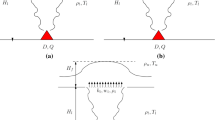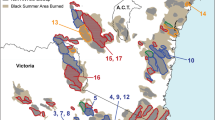Abstract
In connection with ecological and climatic problems and, in particular, the “nuclear winter” theory much attention has recently been paid to the study of the possible consequences of large fires and explosions [1–5]. Below, on the basis of the model proposed in [6, 7] we investigate the initial stage of development of a fire induced by the light emitted by a powerful explosion in the atmosphere. The situation above the seat of combustion (the aerodynamics of the layer of air adjacent to the ground, the configuration and characteristics of the smoke cloud formed) is analyzed.
Similar content being viewed by others
References
M. 1. Budyko, G. S. Golitsyn, and Yu. A. Izrael',Global Climatic Catastrophes [in Russian], Gidrometeoizdat, Moscow (1986).
E. P. Velikhov (ed.),The Climatic and Biological Consequences of Nuclear War [in Russian], Nauka, Moscow (1986).
The Effects on the Atmosphere of a Major Nuclear Exchange, Nat. Acad. Press, Washington (1985), p. 193.
“Nuclear energetics and international security,”Priroda, No. 6, 3 (1985).
M. L. Asaturov, M. I. Budyko, K. Ya. Vinnikov, et al.,Volcanoes, the Stratospheric Aeorosol and the Earth 's Climate [in Russian], Gidrometeoizdat, Leningrad (1986).
G. M. Makhviladze and S. B. Shcherbak, “Calculation of the convective motion of the gas above the surface of burning material,” Preprint No. 125 [in Russian], Institute of Problems of Mechanics, USSR Academy of Sciences (1979).
M. Makhviladze, “Unsteady two-dimensional flows in the gasdynamics of slow combustion” Author's Abstract of Doctoral ssertation [in Russian], Institute of Problems of Mechanics, USSR Academy of Sciences, Moscow (1982).
e Effects of Nuclear Weapons, U.S. Gov. Print. Off., Washington (1964), p. 730.
V. Konev,Physical Basis of the Combustion of Plant Materials [in Russian], Nauka, Novosibirsk (1977).
A. M. Grishin,Mathematical Models of Forest Fires [in Russian], Izd. Tom. Un., Tomsk (1981).
T. L. Clark, “Numerical simulations with a three-dimensional cloud model: lateral boundary condition experiments and multicellular severe storm simulations,”J. Atmos, Sci.,36, 2191 (1979).
R. D. Small and D. A. Larson, “Velocity fields generated by large fires,”Israel J. Technol.,22, 173 (1984).
Yu. A. Gostintsev, V. V. Lazarev, A. F. Solodovnik, and Yu. V. Shatskikh, “Turbulent thermal in a stratified atmosphere,”Izv. Akad. Nauk SSSR, Mekh. Zhidk. Gaza, No. 6, 141 (1986).
G. M. Makhviladze, O. I. Melikhov, and S. E. Yakush, “Turbulent axisymmetric thermal in a nonuniform compressible atmosphere. Numerical investigation,” Preprint No. 303 [in Russian], Institute of Problems of Mechanics, USSR Academy of Sciences (1987).
R. D. Small and K. E. Heikes, “Early cloud formation by large area fires,”J. Appl. Meteorol,27, 654 (1988).
Author information
Authors and Affiliations
Additional information
Translated from Izvestiya Rossiiskoi Akademii Nauk, Mekhanika Zhidkosti i Gaza, No. 1, pp. 17–25, January–February, 1992.
Rights and permissions
About this article
Cite this article
Gostintsev, Y.A., Makhviladze, G.M. & Novozhilov, V.B. Formation of a large radiation-induced fire. Fluid Dyn 27, 13–18 (1992). https://doi.org/10.1007/BF01054166
Received:
Issue Date:
DOI: https://doi.org/10.1007/BF01054166




